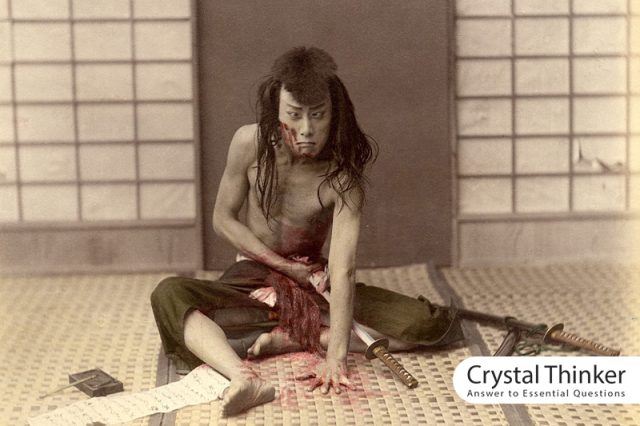What is Seppuku? Do you know about this method of suicide? The word hara-kiri has a similar meaning to the word Seppuku. Both of these words naturally refer to abdominal incisions for suicide.
Who committed suicide by the Seppuku method?
Many people are familiar with this method of suicide, and when they hear this word, they think of a Japanese person. As for the phrase Seppuku, you should know that this method is not just a kind of Japanese ritual suicide. In this method of suicide, a person hits his abdomen. In this way, the person will lose his life due to severe bleeding in the intestinal tract. Samurai used this method of suicide to avoid being tortured, captured, and killed by their enemies.
Seppuku is a voluntary act done to die with pride. Of course, it is interesting to know that the samurai used the Seppuku method to punish the violators. This method was considered one of the most common methods for samurai punishment.

Seppuku is an action similar to execution for samurai.
Samurai who committed severe offenses lost their lives in the Seppuku method. Seppuku’s process was similar to the death sentence for these people.
Seppuku was a ritual performed in front of an audience. To do this, people insert a short blade into their abdomen and move the edge from left to right to complete the abdominal incision.
People trying to do Seppuku are trying to complete these actions because if the cut is deep enough, it can cut the abdominal aorta and cause rapid death of a person because bleeding will be very high in these conditions.
The first recorded act of Seppuku was in 1180 and was performed by Minamoto no Yorimasa. This action took place during the Battle of Uji. (Turnbull, 2002)
Meaning and use of the word Hara-kiri vs. Seppuku
Hara-kiri is a common term among ordinary people, and we see the phrase Seppuku in written texts.
Among the speeches of the upper classes of society, we also hear the phrase Seppuku instead of hara-kiri for the same act.
Seppuku planned and sudden.
The more elaborate ceremony meant that Seppukoy was pre-planned and was usually present in the audience during the performance and watched closely. But Seppuku, performed on the battlefield, was unplanned and typically sudden.
The samurai bathed the person who had committed suicide in the seppuku method in cold water to prevent severe bleeding.

It is interesting to know that special ceremonies were for the planned Seppuku. A person wore a white dress before the Spoku operation and served his favorite food for the last time.
After he served his food, someone would put a special knife in the cloth and hand over the blade to anyone who wanted to commit suicide. The man also wore a ceremonial robe, usually a white kimono, and placed a small sword on the ground in front of him. Then he would sit in his unique clothes and write a few lines of death poems and prepare for death.
Narratives and stories suggest that the person will drink before committing suicide in this ritual. (Gately, 2009)
Has there been ritual suicide for women as well?
Yes, women also committed suicide by committing certain acts. Note that women tied their legs before doing this, and this is one of the main features of female Seppuku.
The purpose of tying the legs was to ensure proper posture at the time of death.
Of course, female ritual suicide is mistakenly referred to as jigai in some English sources.
Some women in the samurai family committed suicide by cutting their neck veins with a single blow and using a knife.

The primary purpose of this work was to die quickly and thoroughly. These women wanted to kill themselves, not be captured by the enemies or persecuted.
During the war, invading armies often raided homes to capture women and children alone at home. But as soon as the women noticed that the military was approaching their house, they killed themselves in the way we described.
Seppuku in today’s world
As stated in this article, if Non-samurai people perform Seppuku, it will not make much sense.
Some current academic papers have argued about how high suicide rates in Japan relate to the old Seppuku tradition.
As we mentioned, Seppuku took the time to accept responsibility for the mistakes. For this reason, suicide is one of the ways to get rid of social and political problems today.
There is a close relationship between legal responsibility and moral responsibility in Japanese culture. That is why people use suicide to make up for the legal stigma.
Throughout Japanese history, we have always seen that some Japanese politicians decided to commit suicide to end their lives after an unpleasant act.
Myths about Seppuku
Samurai always performed Seppuku after the death of their master. This act is called jun shi, oi-bara, or toma-bara.
In Japan, the two words mean “to accompany.”
Although this rarely happened, they always wanted to end their lives after the death of their master. This act was not a pre-determined and unwritten law.
If you search the history books of Japan, you will not find any examples of seppuku reversal.
Today, only 2.2 percent of suicides in Japan are related to gastric bypass.

Samurai did not wash their heads with hot water before performing the seppuku operation to increase bleeding.
In the Temple of Eugene in Kyoto, you can see traces of the actual blood of the samurai who collectively Seppuku to preserve the Tori Mototada.
Conclusion
In this article, we will introduce you to an old method of suicide in Japan. We hope you find this article interesting. If so, please share it with your friends. We are always looking for exciting and thought-provoking content on the crystal thinker website and its various social networks such as Facebook, Instagram, Twitter, LinkedIn, Pinterest, and Telegram.
We are glad that you are with us. If you share your comments with us, we can prepare better content for you.
Resources:
- Turnbull, S. (2002). Samurai Invasion: Japan’s Korean War 1592 -1598. Cassell.
- Gately, I. (2009). Drink: A Cultural History of Alcohol (Illustrated ed.). Avery.








